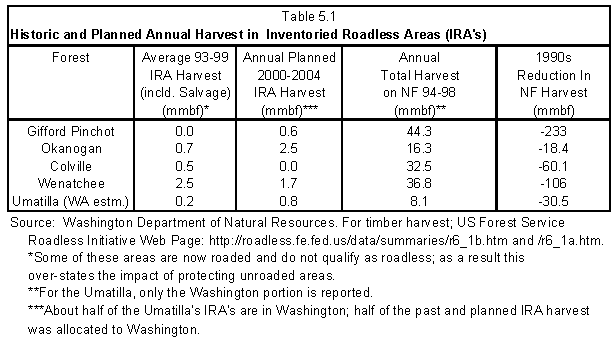
by
Thomas Michael Power, Ph.D.
Professor
of Economics, University of Montana
Chapter 5
The Projected Economic Impacts of Protecting
Washington's Roadless Areas
We have reviewed the economic impacts of very large past reductions in National Forest timber harvests on the economies of eastern and southwest Washington's communities and has explored the economic role that protected natural landscapes have played in supporting economic vitality in Washington's rural and urban areas. The study now looks at the likely economic impacts of protecting all of Washington's inventoried roadless areas.
A. The Expected Reduction in Federal Timber Harvests and Forest Products Employment if Roadless Areas Cannot Be Logged
It was not oversight or happenstance that has led some of Washington's forested mountains to remain roadless with little or no past timber harvest in them. In general, the pursuit of commercially valuable timber first focuses on the most profitable sites. Sites that were cheaply accessible, where harvest costs were low, and where timber site productivity was high tended to be harvested first. Sites that required the construction of expensive transportation systems, involved the use of high cost harvest techniques, had low valued standing inventory, or were costly to regenerate after harvest tended to be avoided. In the past, these were simply commercial business considerations. More recently, environmental constraints have been incorporated into both law and regulation, further raising the cost of entering certain areas to harvest timber.
As a result of these economic and environmental constraints, some areas simply are not viable for commercial timber production. They can be managed for timber only at an economic loss. In the mid-1980s, National Forest plans evaluated each part of the National Forests for their suitability for various uses including commercial timber harvest. (1) At that time much of the roadless acreage was found to be unsuitable for commercial timber management or found to have non-timber values that took precedence over commercial timber values. On the Umatilla, for instance, two-thirds of the roadless acreage was not allocated to commercial timber management and on the Colville over half. This simply confirmed past judgments that had led timber harvest to be focused elsewhere and resulted in these areas remaining roadless with significant forested acres outside of the commercial timber base.
i. Actual Timber Harvests in the Inventoried Roadless AreasAs part of the data collection associated with the Clinton Administration's Roadless Area Initiative, each National Forest's staff was asked to calculate the amount of timber that had been harvested from inventoried roadless areas between 1993 and 1999. In addition, each forest's staff was asked to indicate the timber it expected to harvest from these roadless areas between 2000 and 2004. This provides a twelve-year record of the contribution that these roadless areas have been making to National Forest timber harvests. As will be discussed below, this approach may under-estimate the long run contribution that the roadless areas make to National Forest timber harvests. For now, we will accept this as a reasonable beginning point from which to estimate the roadless areas' contribution to timber harvests over the next five years or so.
For eastern and southwest Washington, the National
Forests reported very low reliance on roadless areas for either past or
future timber harvest. The largest roadless area past or projected future
harvest -- 2.5 million board feet per year -- was found in the Okanogan
and Wenatchee National Forests. On other National Forests -- the Colville,
Umatilla, and Gifford Pinchot -- the roadless area harvests were less than
one million board feet a year. If protecting roadless areas led this harvest
to be abandoned and none of it was made up on other public and private
lands, timber harvest would decline by this amount and local economic activities
dependent on that harvest would be reduced. Such a reduction would be very
small compared to the declines that took place in the 1990s. See Table
5.1.

If this reduction in National Forest harvests results in the timber that is available for processing at local mills to decline by a similar amount, it may lead to a reduction in employment and income at those mills. Although mill employment has not mechanically followed fluctuations in National Forest timber harvests in the past, we can estimate the maximum direct impact on employment by assuming such a rigid connection and applying the Forest Service's employment "response coefficients." These response coefficients estimate the reduction in employment in logging, milling, pulp, and paper production associated with the processing of each million board feet of timber harvested. As discussed earlier and as will be discussed in the next section, these response coefficients are implausibly large given responses to past declines in harvest. If, conservatively, we accept these measures of employment impacts from each million board feet of federal timber harvested, we can estimate the upper limit on the size of the short run (five years or so) employment impact of protecting these roadless areas. This is detailed for various Washington geographic areas in Tables 5.2 and 5.3.
The forest products employment associated with
the past and projected roadless area timber harvests is quite low in all
of the multi-county areas upon which this report has focused, between a
half-dozen and three dozen jobs depending upon the geographic area. Even
when entire Congressional Districts are the focus, the employment associated
with the roadless area timber harvests is two to three dozen jobs. See
Table 5.2.
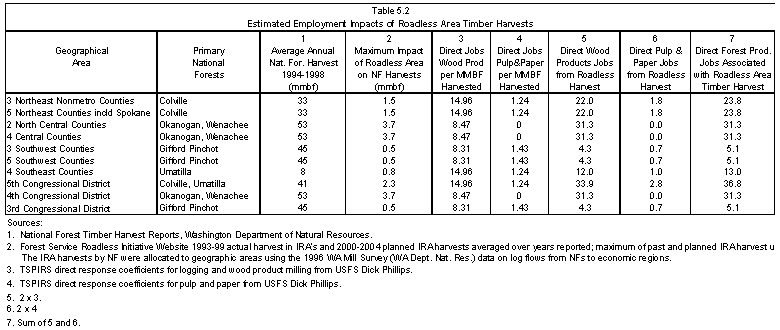
In terms of total employment, these jobs are mere
hundredths of one percent except for the three northeast rural counties
where they represent a maximum of one-tenth of one percent of jobs. In
terms of forest products employment, the jobs associated with roadless
area harvests are also quite small, about one percent of forest products
jobs in all but Okanogan and Chelan Counties where they represent about
3 percent of forest products jobs. Another way to consider the relative
size of these employment impacts is to compare these potential jobs with
the job growth that has been taking place during the 1990s. In most cases
these jobs represent just a few days of normal job growth, 1 to 8 days
of job growth. In the three northeast rural counties these potential jobs
represent about two weeks of normal job growth. That is, the employment
"cost" of protecting all of these roadless areas is a one-day to two-week
pause in the ongoing process of job creation. See Table 5.3.
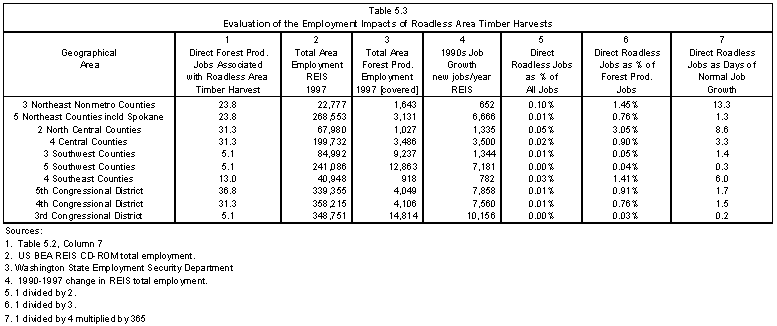
ii. The Roadless Areas' Contributions to Maximum Long Term Timber HarvestsAlthough this twelve year history used above to estimate the contribution the roadless areas have been making to National Forest timber harvests provides a good measure of the actual timber harvests taking place within the roadless areas and likely harvests over the next five years or so, those areas can also contribute indirectly to total timber harvests. National Forest Service staff estimate the maximum allowed harvest by estimating the annual incremental timber growth on the forestland being managed for timber. The actual harvest, however, does not take place uniformly across the forest each year. Timber growth in one part of the timber base may support timber harvests in a quite different location. In that sense, timber harvests in roaded areas may be partially supported by the timber productivity of the roadless areas. If those roadless areas are removed from the commercial timber base, the calculated maximum allowable harvest would also have to be reduced. In this setting, the contribution that the roadless areas make to potential harvests should be measured by the contribution that those roadless areas made to the calculated Allowable Sale Quantity (ASQ) or Probable Sale Quantity (PSQ).
When a National Forest's timber is harvested at approximately its ASQ or PSQ, that approach would make sense. When National Forest timber harvests have been only a small fraction of their ASQ for many years and when it is highly likely that the historical ASQ will be dramatically reduced in future forest plan revisions, this approach would produce a misleading estimate of the contribution the roadless areas are actually making to federal timber harvests. In Washington, the Okanogan, Colville, and Umatilla timber harvests between 1994-1998 have been only a quarter to a third of the ASQs set in the 1980s. Those ASQs no longer tell us what actual timber harvest will be and, therefore, cannot tell us anything about the contribution the roadless areas will make to federal harvests. Even some of the PSQs on the "owl" forests do not reflect actual harvests. For instance, the PSQ for the Gifford Pinchot NF was set at 73 mmbf in 1994 and lowered to 65 mmbf in 1998. The 73 mmbf was 62 percent above the actual harvest between 1994 and 1998 and even the 65 mmbf PSQ is 44 percent above that actual harvest.
Given that past planned harvests do not accurately represent either current or future harvests, we have used the average harvests on the National Forests for the period 1994-1998 to estimate the likely future levels of harvest. These are shown in Column 1 of Table 5.5.
Although the historical ASQs cannot be used to indicate future timber harvests, the relative contribution of the roadless areas to those maximum allowed harvests may provide an indication of the roadless areas' contribution to the current level of harvest. Inventoried roadless areas are estimated to contribute 16.9 percent of the PSQs associated with the Washington "owl" forests. For the Gifford Pinchot it is 15.8 percent; for the Wenatchee, 21.5 percent; and for the "owl" part of the Okanogan, 10 percent. (2) For the "non-owl" eastern Washington forests, we use the contribution roadless areas were estimated to make to timber harvests at the time the individual forest plans were adopted. For the Colville, the roadless areas contributed 16 percent of the suitable timber acreage; for the Umatilla it was 17.5 percent. (3) In the analysis below (Column 2 of Table 5.5) we use these estimates of the contributions that roadless areas make to the National Forests' PSQs and ASQs to measure the long-term impact of setting these areas off limits to logging.
This approach leads to significantly larger estimates
of the impact of putting the inventoried roadless areas off limits to logging,
3.6 times larger than the Forest Service's estimates for the next five
years based on historical and planned harvest within the roadless areas.
See Table 5.4 which presents the results of calculations found in Column
3 of Table 5.5.
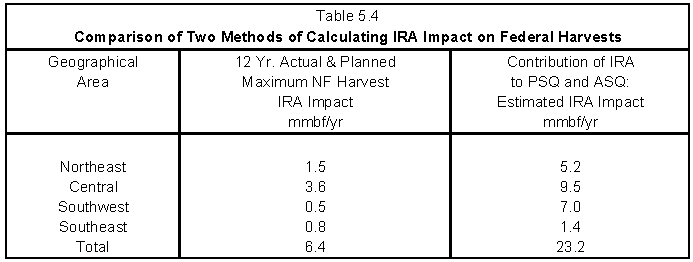
As we have repeatedly pointed out, when National Forest timber harvests change, forest products employment does not mechanically and proportionally change. There are other complex and offsetting changes. We can estimate the maximum impact by taking the average forest products employment per million board feet of total timber harvest for eastern and southwestern Washington. This has been about 9 direct forest products jobs per million board feet in eastern Washington between 1994 and 1998. For the southwest counties we have used the Forest Services IMPLAN direct employment multiplier of 9.74. (4) Table 5.5 (Column 4) uses these mechanical timber harvest employment multipliers to estimate an upper limit for the direct employment impact that the loss of the inventoried roadless areas' timber productivity would have in each county.
Even assuming that protecting the inventoried
roadless areas would have a much larger impact on federal timber harvests
than the Forest Service has estimated, the impacts are still quite small,
214 jobs out of a total employment in these particular counties of over
750,000. Expressed in terms of annual job growth during the 1990s, the
impact would be the equivalent of a five day long pause in ongoing job
growth. As a percentage of total employment, these roadless area potential
timber jobs represent a small fraction of one percent (0.00 to 0.5 percent)
in all of these counties except Skamania where it represents about 1.6
percent of all jobs. Recall that the slow growth of jobs and limited employment
opportunities within Skamania county are associated with a growing
population that commutes to expanding employment opportunities in adjacent
counties.
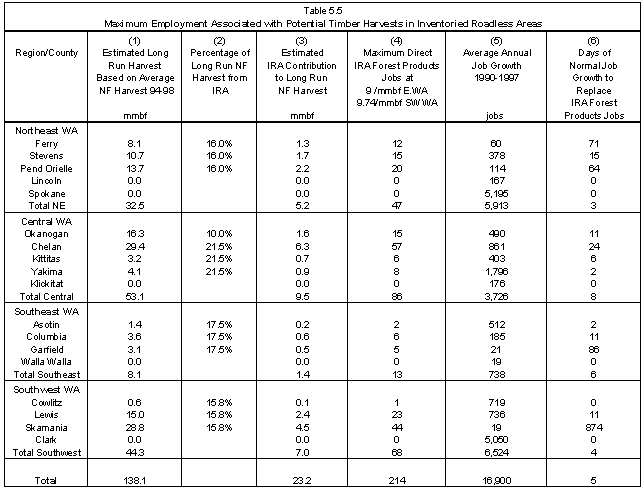
B. The Expected Impact of Roadless Area Protection on Federal Payments to Counties
During the second half of the 1990s, the average payment to eastern Washington counties associated with the 25 percent share of the value of National Forest timber harvests has been about $55,000 per million board feet harvested. (5) This value fluctuates with the stumpage value of federal timber, rising as stumpage values rise. The timber harvests from the roadless areas is between 0.5 and 2.5 mmbf per year depending on the National Forest. The impact on payments to counties would be $27,500 to $137,500 per year spread over the group of counties where the timber harvest takes place. For any given county the impact would be $25,000 to $100,000 per year, a very small impact given the size of county government budgets. Okanogan County, for instance, which would face a larger impact than most counties, had total revenues of about $30 million in 1998 and saw county revenues grow by $1.8 million per year during the 1990s. One hundred thousand dollars would represent about three-tenths of one percent of that total revenue and 6 percent or about three weeks of one year's growth in those revenues.
If congressional efforts to decouple National Forest payments to counties from annual timber harvests are successful, payments would rise dramatically, back to the levels associated with the peak harvests of the late 1980s. Such a rise would offset any decline associated with roadless areas many, many fold. Then those payments would remain relatively constant even if forest management decisions led to somewhat lower timber harvests. In that setting, decisions about the management of Washington's roadless areas would not affect payments to local governments.
C. The Economic Value of Protecting the Roadless Areas
The purpose of protecting roadless areas from road building and logging is to protect a wide range of forest values that are damaged by roads and timber harvest. In economic terms, there is a benefit of protecting the remaining roadless areas in addition to the small costs discussed above. That benefit is the continuing availability, indefinitely into the future, of the environmental services those roadless areas provide: recreation, open space, scenic beauty, water and water quality, wildlife, fisheries, climate stabilization, etc.
Because people care where they live and act on those preferences, higher quality living environments tend to attract both people and economic activity. Changes in our economy and in transportation and communication technologies have reduced the cost to people and firms of acting on their preferences for higher quality living environments. This has increased the economic importance of quality of life in the local economic base.
Protecting Washington's remaining roadless areas protects one of the sources of the state's ongoing economic vitality, including the economic vitality of its forested eastern and southwest counties. Roadless area protection preserves the types of recreation settings that are most scarce now and that will be even more scarce relative to demand in the future. About 80 percent of Washington's land base is already open to motorized activity. There is no shortage of roaded landscapes in Washington that calls out for still more allocations of natural landscapes to the roaded category. In that economic context roadless area protection lays the basis for higher levels of current and future economic well-being. Rather than impoverishing Washington's National Forest counties, roadless area protection strengthens their current and future economic base and the sectors of the economy that will be the source of additional jobs and income.
2. Region 6 Memo on Current Timber Management Plan Volumes, Nancy Graybeal to Donald Parks, Dated September 27, 1999.
3. These calculations were reported in Table 1a of Appendix A of the author's "The Timber Employment Impact of the Northern Rockies Ecosystem Protection Act in Washington and Oregon," Economics Department, University of Montana, Missoula, MT, 59812, August 1992.
4. Because of the complex flow of logs in the southwest counties, the average employment per mmbf harvested could not be used. Instead, the Gifford Pinchot IMPLAN direct employment multiplier, 9.74 jobs per mmbf, was used. See multiplier data from Dick Phillips, USFS Region 6 Regional Economist, February 15, 2000. This is the data used in TSPIR reports to Congress. The similar IMPLAN multiplier for the Inland Empire was not used because its value (16.2) was so much larger than the average employment per mmbf. The IMPLAN multiplier for the Wenatchee and Okanogan, 8.47, was below the multiplier of 9 that was used.
5. National Forests not associated with spotted owl management were focused upon since the "owl forests" had payments to counties guaranteed for most of the 1990s. This protection of payments to counties when other forest management objectives lead timber harvest to decline is what is being sought for all forests by those who support decoupling payments from timber harvests.